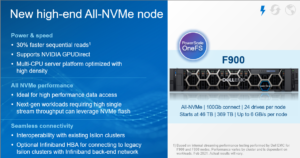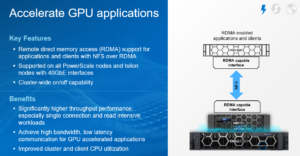It’s release season here and we’re delighted to introduce both PowerScale OneFS 9.2 and the new PowerScale F900 all-flash NVMe node.

The PowerScale F900 will be the highest performing platform in the PowerScale portfolio. It’s based on the Dell R740xd platform, and features dual socked 24-core 2.2GHz Intel Xeon Gold CPU, 736 GB of RAM, 100Gb Ethernet or QDR Infiniband backend, and twenty four 2.5 inch NVMe drives per 2U node. These drives are available in 1.9TB, 3.8TB, 7.4TB and 15TB sizes, yielding 46TB, 92TB, 184TB, and 360TB raw node capacities respectively, allowing the F900 to deliver up to 93PB of raw NVMe all-flash capacity per cluster.

A recent Forrester Total Economic Indicator (TEI) study showed that the F900 can deliver an ROI of up to 374% and a payback period of less than 6 months. Plus it can be consumed either as an appliance or as an APEX Data Storage Service.

The F900 can scale from 3 to 252 nodes per cluster, and inline data reduction is enabled by default to further extend the effective capacity and efficiency of this platform.
With the latest OneFS 9.2, we have also powered up the F600 and F200, launched last year. There’s higher performance with up to 70% increase in sequential reads for F600 and up to 25% for sequential reads for the F200. Plus customers also get more flexibility through new drive options, and the ability to non-disruptively add these nodes to existing Isilon clusters. Finally, customers get data-at-rest encryption through self-encrypting drives (SED) on F200.
OneFS 9.2 also introduces Remote Direct Memory Access support for applications and clients with NFS over RDMA, and allows substantially higher throughput performance, especially for single connection and read intensive workloads such as M&E edit and playback and machine learning – while also reducing both cluster and client CPU utilization. It also provides a foundation for future OneFS interoperability with NVIDIA’s GPUDirect.

Specifically, OneFS 9.2 supports NFSv3 over RDMA by leveraging the ROCEv2 network protocol (also known as Routable RoCE or RRoCE). New OneFS CLI and WebUI configuration options have been added, including global enablement, and IP pool configuration, filtering and verification of RoCEv2 capable network interfaces. Be aware that neither ROCEv1 nor NFSv4 over RDMA are supported in the OneFS 9.2 release. And IPv6 is also unsupported when using NFSv3 over RDMA
NFS over RDMA is available on all PowerScale which contain Mellanox ConnectX network adapters on the front end with either 25, 40, or 100 Gig Ethernet connectivity. The ‘isi network interfaces list’ CLI command can be used to easily identify which of a cluster’s NICs support RDMA.
The new 9.2 release introduces External Key Management support for encrypted clusters, through the key management interoperability protocol, or KMIP, which enables offloading of the Master Key from a node to an External Key Manager, such as SKLM, SafeNet or Vormetric. This allows centralized key management for multiple SED clusters, and includes an option to migrate existing keys from a cluster’s internal key store.
This feature provides enhanced security through the separation of the key manager from the cluster, enabling the secure transport of nodes, and helping organizations to meet regulatory compliance and corporate data at rest security requirements
Configuration is via either the WebUI or CLI, and, in order to test the External Key Manager feature, a PowerScale cluster with self-encrypting drives will be required:
In addition to external key management for SEDs, OneFS 9.2 introduces several other Security & Compliance features, including Administrator-only Log Access, where Security and Federal requirements mandate limiting access to configuration and log information to administrators only for /ifsvar, /var/log, /boot, and a variety of /etc config files and subdirectories.
Also, in OneFS 9.2, the HTTP Basic Authentication scheme will be disabled by default, on new installs requiring session-based authentication. This only impacts the API and RAN endpoints of the web server, including /platform, /object, and /namespace on TCP port 8080. The regular HTTP protocol access on TCP 80 and 443 remains unchanged.
9.2 also introduces a new roles-based administration privilege, ISI_PRIV_RESTRICTED_AUTH, intended for help-desk admins that don’t require full ISI_PRIV_AUTH privileges. This means that an admin with ISI_PRIV_RESTRICTED_AUTH can only modify users and groups with the same or fewer privileges.
While IPv6 has been available in OneFS for several releases now, 9.2 introduces support to meet the stringent USGv6 security requirements for United States Government deployments. In particular, the USGv6 feature implements both Router Advertisements to update the IPv6 default gateway, and Duplicate Address Detection to detect conflicting IP addresses. SmartConnect DNS is also enhanced to detect DAD for the SmartConnect Service IP, allowing it to log and remove an SSIP if a duplicate is detected.
There are also several serviceability-related enhancements in this new release. As part of OneFS’ always-on initiative, 9.2 introduces Drain Based Upgrades, where nodes are prevented from rebooting or restarting protocol services until all SMB clients have disconnected from the node. Since a single SMB client that does not disconnect could cause the upgrade to be delayed indefinitely, options are available to reboot the node, despite persisting clients.
OneFS 9.2 sees a redesign of the CELOG WebUI for improved usability. This makes it simple to filter events chronologically, categorize by their status, filter by the severity, easily search the event history, resolve, suppress or ignore bulk events, and more easily manage scheduled maintenance windows.
9.2 also introduces the ability to export a cluster’s configuration, which can then be used to perform a config restore to either the original or a different cluster. This can be performed either from the CLI or platform API, and includes the configuration for the core protocols (NFS, SMB, S3 and HDFS) plus Snapshots, Quotas, and NDMP backup,
Another feature of OneFS 9.2 is S3 ETag Consistency. Unlike AWS, if the MD5 checksum is not specified in an S3 client request, OneFS generates a unique string for that file as an ETag in response, which can cause issues with some applications. Therefore, 9.2 now allows admins to specify if the MD5 should be calculated and verified.
In 9.2, Energy Star efficiency data is now retrieved through the IPMI interface, and reported via the CLI, allowing cluster admins and compliance engineers to query a cluster’s inlet temperatures and power consumption.
With OneFS 9.2, In-line data reduction is extended to include the new F900 platform. OneFS in-line data reduction substantially increases a cluster’s storage density, and helps eliminate management burden, while seamlessly boosting efficiency and lowering the TCO. The in-line data reduction write pipeline comprises three main phases:
- Zero block removal
- In-line dedupe
- In-line compression
And, like everything OneFS, it scales linearly across a cluster, as additional nodes are added.
We’ll be looking more closely at these new features and functionality over the course of the next few blog articles.